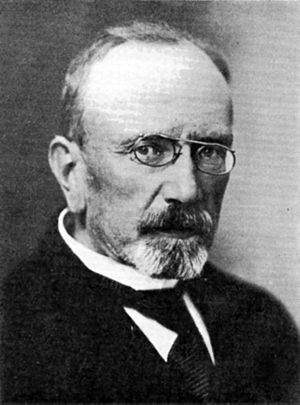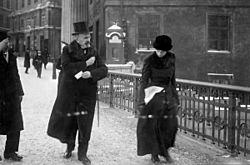Hjalmar Hammarskjöld facts for kids
Quick facts for kids
Hjalmar Hammarskjöld
|
|
|---|---|

Hjalmar Hammarskjöld
|
|
| Prime Minister of Sweden | |
| In office 17 February 1914 – 30 March 1917 |
|
| Monarch | Gustaf V |
| Preceded by | Karl Staaff |
| Succeeded by | Carl Swartz |
| Personal details | |
| Born |
Knut Hjalmar Leonard Hammarskjöld
4 February 1862 Tuna, United Kingdoms of Sweden and Norway |
| Died | 12 October 1953 (aged 91) Stockholm, Sweden |
| Spouse |
Agnes Almquist
(m. 1890; died 1940) |
| Children | 4, including Åke and Dag |
Knut Hjalmar Leonard Hammarskjöld (born February 4, 1862 – died October 12, 1953) was an important Swedish politician, scholar, and government minister. He served as the Prime Minister of Sweden from 1914 to 1917. He was also a Member of Parliament for many years, from 1923 to 1938.
In 1890, he married Agnes Maria Carolina Almquist. They had four sons: Bo, Åke, Sten, and Dag. His youngest son, Dag Hammarskjöld, later became a very famous Secretary-General of the United Nations.
Contents
Hjalmar Hammarskjöld's Early Life and Career
Hjalmar Hammarskjöld was born into the Hammarskjöld family in Tuna, Sweden. His father, Knut Vilhelm Hammarskjöld, was a noble and a landowner. Hjalmar became a skilled legal expert.
He was known for his work as a scholar and a lawmaker. In 1891, he became a professor at Uppsala University. He greatly influenced Swedish and Nordic civil law.
Becoming an Expert in International Law
Hjalmar Hammarskjöld also became a respected expert in international law. He worked hard at many international meetings. In 1904, he joined the Permanent Court of Arbitration in The Hague.
He was an important participant at the Second Hague Peace Conference in 1907. This conference aimed to discuss peace and rules for warfare.
Government Roles Before Prime Minister
From 1901 to 1902, Hammarskjöld was the Minister of Justice. He tried to improve voting rights, but his efforts were not successful. After this, he became the president of the Göta court of appeal.
In 1905, he served as the Swedish ambassador to Copenhagen. He returned to Uppsala in 1907 to become the county governor. However, he often took time off for other important tasks.
Leading Sweden as Prime Minister
In 1914, Hjalmar Hammarskjöld became the head of a new government. This happened after the previous liberal government resigned. His main task was to deal with defense issues for Sweden.
His government was politically independent. It was loyal to the king and had a conservative viewpoint.
Challenges During World War I
Soon after Hammarskjöld became Prime Minister, World War I began. During this time, the different political parties in Sweden agreed to work together. They successfully solved the country's defense problems.
However, Hammarskjöld was very strict about trade rules during the war. This made it difficult to get enough food into Sweden. Because of this, some people started calling him "Hungerskjöld," which means "Hunger shield."
He was also seen as being too friendly towards Germany. He rejected a trade agreement with Great Britain that could have helped Sweden. This caused a disagreement between him and his foreign minister. Eventually, he lost the support of the right-wing party and had to resign in 1917.
Later Life and Legacy
Hjalmar Hammarskjöld was known for his strong personality. Some people thought he was too bossy or stubborn. However, there is no real proof that he favored Germany during the war.
He held many important positions later in his life. He was the chairman of the Nobel Foundation from 1929 to 1947. He also became a member of the Swedish Academy in 1918.
His work helped lead to the creation of the Supreme Administrative Court of Sweden. This court handles important legal cases related to government decisions.
Hjalmar Hammarskjöld passed away on October 12, 1953, in Stockholm. This was just a few months after his youngest son, Dag, became the second Secretary-General of the United Nations. Dag Hammarskjöld also inherited his father's seat in the Swedish Academy.
See also
 In Spanish: Hjalmar Hammarskjöld para niños
In Spanish: Hjalmar Hammarskjöld para niños


